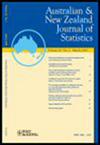Global implicit function theorems and the online expectation–maximisation algorithm
IF 0.8
4区 数学
Q3 STATISTICS & PROBABILITY
引用次数: 5
Abstract
The expectation–maximisation (EM) algorithm framework is an important tool for statistical computation. Due to the changing nature of data, online and mini‐batch variants of EM and EM‐like algorithms have become increasingly popular. The consistency of the estimator sequences that are produced by these EM variants often rely on an assumption regarding the continuous differentiability of a parameter update function. In many cases, the parameter update function is not in closed form and may only be defined implicitly, which makes the verification of the continuous differentiability property difficult. We demonstrate how a global implicit function theorem can be used to verify such properties in the cases of finite mixtures of distributions in the exponential family, and more generally, when the component‐specific distributions admit data augmentation schemes, within the exponential family. We then illustrate the use of such a theorem in the cases of mixtures of beta distributions, gamma distributions, fully visible Boltzmann machines and Student distributions. Via numerical simulations, we provide empirical evidence towards the consistency of the online EM algorithm parameter estimates in such cases.全局隐函数定理和在线期望最大化算法
期望最大化(EM)算法框架是统计计算的重要工具。由于数据性质的变化,EM和类EM算法的在线和小批量变体变得越来越流行。由这些EM变量产生的估计序列的一致性通常依赖于关于参数更新函数的连续可微性的假设。在许多情况下,参数更新函数不是封闭形式,只能隐式定义,这使得连续可微性的验证变得困难。我们演示了如何使用全局隐函数定理来验证指数族分布的有限混合情况下的这些性质,更一般地说,当成分特定分布允许数据增强方案时,在指数族内。然后,我们说明了在β分布、γ分布、完全可见玻尔兹曼机和学生分布的混合情况下使用这个定理。通过数值模拟,我们为在线EM算法参数估计在这种情况下的一致性提供了经验证据。
本文章由计算机程序翻译,如有差异,请以英文原文为准。
求助全文
约1分钟内获得全文
求助全文
来源期刊
CiteScore
1.30
自引率
9.10%
发文量
31
审稿时长
>12 weeks
期刊介绍:
The Australian & New Zealand Journal of Statistics is an international journal managed jointly by the Statistical Society of Australia and the New Zealand Statistical Association. Its purpose is to report significant and novel contributions in statistics, ranging across articles on statistical theory, methodology, applications and computing. The journal has a particular focus on statistical techniques that can be readily applied to real-world problems, and on application papers with an Australasian emphasis. Outstanding articles submitted to the journal may be selected as Discussion Papers, to be read at a meeting of either the Statistical Society of Australia or the New Zealand Statistical Association.
The main body of the journal is divided into three sections.
The Theory and Methods Section publishes papers containing original contributions to the theory and methodology of statistics, econometrics and probability, and seeks papers motivated by a real problem and which demonstrate the proposed theory or methodology in that situation. There is a strong preference for papers motivated by, and illustrated with, real data.
The Applications Section publishes papers demonstrating applications of statistical techniques to problems faced by users of statistics in the sciences, government and industry. A particular focus is the application of newly developed statistical methodology to real data and the demonstration of better use of established statistical methodology in an area of application. It seeks to aid teachers of statistics by placing statistical methods in context.
The Statistical Computing Section publishes papers containing new algorithms, code snippets, or software descriptions (for open source software only) which enhance the field through the application of computing. Preference is given to papers featuring publically available code and/or data, and to those motivated by statistical methods for practical problems.

 求助内容:
求助内容: 应助结果提醒方式:
应助结果提醒方式:


